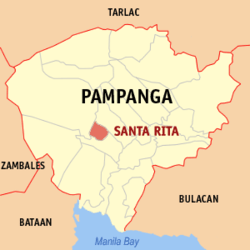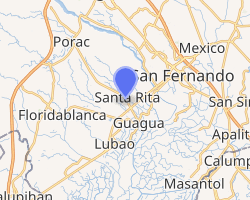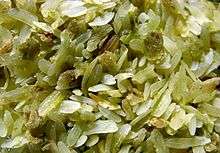Santa Rita, Pampanga
Santa Rita, officially the Municipality of Santa Rita (Kapampangan: Balen ning Santa Rita; Tagalog: Bayan ng Santa Rita), is a 4th class municipality in the province of Pampanga, Philippines. According to the 2015 census, it has a population of 40,979 people.[3]
Santa Rita | |
|---|---|
| Municipality of Santa Rita | |
Downtown area | |
 Seal | |
| Nickname(s): Sesen taya ing Santa Rita | |
 Map of Pampanga with Santa Rita highlighted | |
OpenStreetMap 
| |
.svg.png) Santa Rita Location within the Philippines | |
| Coordinates: 14°59′43″N 120°36′55″E | |
| Country | |
| Region | Central Luzon (Region III) |
| Province | Pampanga |
| District | 2nd District |
| Barangays | 10 (see Barangays) |
| Government | |
| • Type | Sangguniang Bayan |
| • Mayor | Ferdinand L. Salalila |
| • Vice Mayor | Romeo L. Valencia |
| • Congressman | Juan Miguel M. Arroyo |
| • Electorate | 26,022 voters (2019) |
| Area | |
| • Total | 29.76 km2 (11.49 sq mi) |
| Population (2015 census)[3] | |
| • Total | 40,979 |
| • Density | 1,400/km2 (3,600/sq mi) |
| • Households | 8,830 |
| Economy | |
| • Income class | 4th municipal income class |
| • Poverty incidence | 7.03% (2015)[4] |
| • Revenue (₱) | 89,776,265.23 (2016) |
| Time zone | UTC+8 (PST) |
| ZIP code | 2002 |
| PSGC | |
| IDD : area code | +63 (0)45 |
| Climate type | tropical monsoon climate |
| Native languages | Kapampangan Tagalog |
| Website | www |
Sta Rita is popular for the turones de casoy delicacy. It is chiefly a farming town.
The town of Santa Rita belongs to the Second District of Pampanga, along with the towns in the south-western part of the province. It is 79 kilometres (49 mi) from Manila.
Barangays
Santa Rita is politically subdivided into 10 barangays:
- Becuran
- Dila Dila
- San Agustin
- San Basilio
- San Isidro
- San Jose
- San Juan
- San Matias
- Santa Monica
- San Vicente
The largest barangays: Dila-dila and San Basilio occupy 52% of the total municipal land area. Barangays San Agustin and San Vicente with only a space of 2% and 2.13%, of the whole municipal land area are the smallest barangays.
Three barangays compose the poblacion of Santa Rita: barangays San Vicente, San Jose and part of San Matias. Barangay San Vicente serves as the minor Central Business District, It is where the Public Market is located, while Santa Rita Church and the Municipal Hall are located in San Jose. Mixed Old and new houses surround the area.
Climate
| Climate data for Santa Rita, Pampanga | |||||||||||||
|---|---|---|---|---|---|---|---|---|---|---|---|---|---|
| Month | Jan | Feb | Mar | Apr | May | Jun | Jul | Aug | Sep | Oct | Nov | Dec | Year |
| Average high °C (°F) | 30 (86) |
31 (88) |
33 (91) |
34 (93) |
33 (91) |
31 (88) |
29 (84) |
29 (84) |
29 (84) |
30 (86) |
31 (88) |
30 (86) |
31 (87) |
| Average low °C (°F) | 19 (66) |
20 (68) |
21 (70) |
23 (73) |
25 (77) |
25 (77) |
25 (77) |
25 (77) |
24 (75) |
23 (73) |
22 (72) |
20 (68) |
23 (73) |
| Average precipitation mm (inches) | 8 (0.3) |
9 (0.4) |
15 (0.6) |
34 (1.3) |
138 (5.4) |
203 (8.0) |
242 (9.5) |
233 (9.2) |
201 (7.9) |
126 (5.0) |
50 (2.0) |
21 (0.8) |
1,280 (50.4) |
| Average rainy days | 3.7 | 4.1 | 6.5 | 11.2 | 21.2 | 24.9 | 27.7 | 26.5 | 25.5 | 21.8 | 12.6 | 5.6 | 191.3 |
| Source: Meteoblue [5] | |||||||||||||
Demographics
|
| ||||||||||||||||||||||||||||||||||||||||||||||||
| Source: Philippine Statistics Authority[3][6][7][8] | |||||||||||||||||||||||||||||||||||||||||||||||||
In the 2015 census, the population of Santa Rita, Pampanga, was 40,979 people,[3] with a density of 1,400 inhabitants per square kilometre or 3,600 inhabitants per square mile.
Economy
Santa Rita is a fourth class municipality in the province of Pampanga, Philippines.
Local government
Like other towns in the Philippines, Santa Rita is governed by a mayor and vice mayor who are elected to three-year terms. The mayor is the executive head and leads the town's departments in executing the ordinances and improving public services. The vice mayor heads a legislative council (Sangguniang Bayan) consisting of councilors from the Barangays or Barrios.
The municipal government is divided into three branches: executive, legislative and judiciary. The judicial branch is administered solely by the Supreme Court of the Philippines. The LGUs have control of the executive and legislative branch.
The executive branch is composed of the mayor and the barangay captain for the barangays.[9] The legislative branch is composed of the Sangguniang Bayan (town assembly), Sangguniang Barangay (barangay council), and the Sangguniang Kabataan for the youth sector.
The seat of Government is vested upon the Mayor and other elected officers who hold office at the Town hall. The Sanguniang Bayan is the center of legislation.
Elected officials
The Local Government Unit LGU of Santa Rita, Pampanga's Elected officials for the term of 2016-2019 are:
- Mayor: Ferdinand "Dagi" Lansang Salalila
- Vice mayor: Homobono Cunanan Guanlao
- Sangguniang Bayan Members
- Mercedita Bonaobra Carreon
- Romeo Lapid Valencia
- Rebecca Diamzon Magcalas
- Arthur Salalila Jr.
- Alex Lusung Hurtado
- Edison Santos Cubacub
- Renato Quiambao Gopez
- Orlando Carlos Santos
- Liga ng mga Barangay Municipal Chapter President: Punong Barangay San Matias: Jay Cruz
- Pederasyon ng Sangguniang Kabataan Municipal Chapter President: SK Chairwoman Anna Veronica K. Salas
(San Basilio)
Heritage, culture, landmarks and attractions
Dúman (Green Gold) festival & Santa Rita Delicacies
Santa Rita is the home of Dúman and Ocampo-Lansang Delicacies (Turones de Casuy, Sansrival, Uraro and other sweets that sell in SM City Malls nationwide).
Dúman is made of malagkit rice (lacatan malútû) that is beaten from its husks and toasted in a clay oven. To the rest of the country, it may just be plain green rice or even un-popped pinipig. But it is a prized seasonal food that can be found during the Christmas season, after the rice harvest in November. The younger kernels of rice that don’t fall off the husks are colored green. These husks are beaten against a hard surface until they fall off. They are then soaked in water, cooked for 30 minutes and then pounded. This rigorous process helps release the sweet oils and nuttiness of the rice.[10]
Families who produce duman rice are called Mágdurúman. They pass their methods from generation to generation and have kept to the manual production process. Throughout Pampanga, street vendors selling green rice in bilaos or flat baskets are seen. These vendors often sell dúman near churches or marketplaces. It can be eaten plain and munched on like popcorn. It can also be snacked on in spoonfuls with sugar, or made into rice cakes. Kapampangans also like adding dúman to other dishes like fresh carabao’s milk or hot chocolate as a breakfast cereal, or even ice cream.
Harvested and processed through the end of December, dúman is usually eaten with fresh carabao milk (gátas damúlag) for breakfast or stirred into sucláti (drinking chocolate made with Philippine cacao). In Santa Rita, a Pampangan municipality and the epicenter of dúman production, the eagerly awaited specialty is honored annually with its own festival.
Years ago, during dúman season, Santa Rita’s streets rang daily with the “tok-tok” of baseball bat-sized wooden pestles hitting meter-high mortars as lacatan malútû, a red-husked variety of glutinous rice, was transformed into dúman. Nowadays, only a few barangays engage in the laborious and time-consuming production process.
The Dúman Festival started in 2002, which originated from the long-standing tradition of pounding and winnowing unripe glutinous rice (lacatan). The festival features alfresco dining in front of the Santa Rita Church patio were rows and rows of delicacy stalls would sell various pastries and native dishes of the town with duman being the major highlight. The food sold during the festival would include native pastry attractions of the town like sansrival, masa podrido, mamón and mamón tostado.
Dúman is relatively expensive. Food critic Claude Tayag explains that unlike the regular rice variety, which can be planted and harvested three times a year, dúman can only be harvested in the cool air of November and December, otherwise it will not be a bountiful one. For every hectare (San Agustín and Santa Mónica), a farmer can produce only a maximum of 4.5 cavans of duman, while a maximum of 300 cavans can be harvested from the regular rice variety. Dúman prices range from P600 to P1,000 per kilo depending on the quality.[11][12] [13]
 Duman with flowers
Duman with flowers Blooming duman in November
Blooming duman in November Macro portrait of the grains
Macro portrait of the grains Green gold in the bilao
Green gold in the bilao
Santa Rita de Casia Parish Church
The heritage Church is under the jurisdiction of the Roman Catholic Archdiocese of San Fernando.
Fr. Pedro de San Nicolas served as minister of both Porac and Santa Rita in 1722, but it was only in 1726 when Santa Rita had its own priest and therefore became an independent parish. Fr. Francisco Royo built the present church in 1839; Fr. Juan Merino completed it in 1868. These two priests also opened the road linking Santa Rita with Porac and Guagua. During the Revolution, the townspeople hid their last Augustianian parish priest, Fr. Celestino Garcia in their houses until the forces of Gen. Maximino Hizon captured him in Bacolor and took him all the way to Lepanto in the Cordilleras.
Building of the church had to be delayed until the late 19th century due to economic adjuristicial conditions. The single-nave church is 55m long, 13m wide and 10m high. It has a large and well lit transept. The solid brass facade has baroque characteristics and the single columns are relatively slender.[14][15][16]
5 Heritage bells
- Santa Rita of Casia Parish Church
- Heritage Bell tower
- Main altar
- Interior
- Chapel (nearby San Vicente)
The reliquary
The parish is the site where the Holy Relic of Saint Rita de Cascia is enshrined. The parish first obtained the First Class Relic of the saint through the help and assistance of His Excellency, Most Rev. Riccardo Fontana of Spoleto-Norcia, Italy, the archdiocese to which Cascia belongs. Archbishop Fontana forwarded the Relic through the mediation of the Apostolic Nunciature in Manila to Archbishop Paciano Aniceto who in turn handed it over to the parish of Santa Rita de Cascia on August 17, 2008. The First Class Relic is from the flesh “ex carne”of the Saint. As noted in its accompanying Certificate of Authenticity, the relic was part of the last batch extracted from the incorrupt body of Saint Rita on 20 August 1972.
The reliquary is laid open for public veneration every August 17. St. Rita of Cascia (1381) was born in the Italian town of Roccaporena. When her husband and twin sons died, she entered the Augustinian Nuns. The next 40 years of her life saw St. Rita devoting herself to a life of prayer, and works and deeds of charity as dictated by the rules of St Augustine. At age 60, while meditating before the cross, a wound seeming afflicted by a thorn appeared on her forehead. St. Rita began boring the sign of stigmatization which is considered being one with Jesus. Because of the stigmata, she suffered in pain for the next 15 years which she courageously accepted. St. Rita died on May 22, 1457. Her intact and incorrupt body is kept and honored in the shrine at her hometown on Cascia, Italy.[14][15][16][17]
- Altar of St.Joseph
- Altar of St. Rita de Casia
- St. Rita with the Reliquary in her heart
- Closer photo
- Altar of Apparition
- Façade of Villa Epifania
- Villa Epifania: The Grand Old House of Santa Rita
- Film site of "Tinimbang Ka Ngunit Kulang" & "Tanging Yaman")
- The ancestral lot was owned by the Guanzon patriarch Don Agapito Guanzon (Captain Pitong) the then Captain Municipal (equivalent to today’s municipal mayor) of Santa Rita.
- Cultural treasure of Santa Rita
- The mansion is administered by the heirs of Felipe Guanzon y Epifania Alvendia
References
- "Municipality". Quezon City, Philippines: Department of the Interior and Local Government. Retrieved 31 May 2013.
- "Province: Pampanga". PSGC Interactive. Quezon City, Philippines: Philippine Statistics Authority. Retrieved 12 November 2016.
- Census of Population (2015). "Region III (Central Luzon)". Total Population by Province, City, Municipality and Barangay. PSA. Retrieved 20 June 2016.
- "PSA releases the 2015 Municipal and City Level Poverty Estimates". Quezon City, Philippines. Retrieved 1 January 2020.
- "Santa Rita: Average Temperatures and Rainfall". Meteoblue. Retrieved 5 May 2020.
- Census of Population and Housing (2010). "Region III (Central Luzon)". Total Population by Province, City, Municipality and Barangay. NSO. Retrieved 29 June 2016.
- Censuses of Population (1903–2007). "Region III (Central Luzon)". Table 1. Population Enumerated in Various Censuses by Province/Highly Urbanized City: 1903 to 2007. NSO.
- "Province of Pampanga". Municipality Population Data. Local Water Utilities Administration Research Division. Retrieved 17 December 2016.
- Local Government Code of the Philippines, Book III Archived 2009-03-26 at the Wayback Machine, Department of Interior and Local Government official website
- Duman: The Little Known Pampango Treat | OpenRice Philippines
- 10th Duman Festival all set on December 3 | Sun.Star
- [eK!] sta. rita, pampanga, philippines: profile & brief history
- http://100poundfoodie.com/2007/12/10/scenes-from-the-6th-duman-festival/
- Pampanga Churches
- Department of Tourism - The Philippines Ultimate Travel Guide for Tourist
- : Santa Rita de Cascia :. .: History of Santa Rita de Cascia Parish :
- Welcome santaritaparishasf.org - BlueHost.com
External links
| Wikimedia Commons has media related to Santa Rita, Pampanga. |